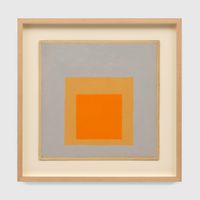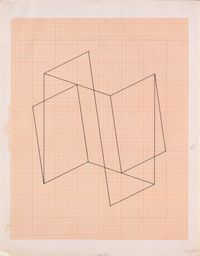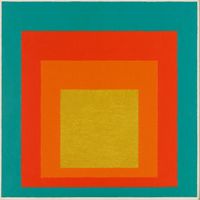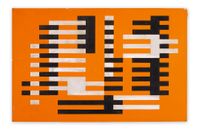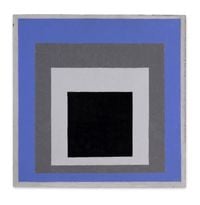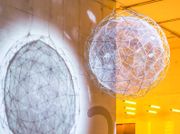Josef Albers was a German-born American artist and educator who remains one of the most influential abstract painters of the 20th century. As a student and later a professor at the Bauhaus, Albers played a significant role in introducing the tenets of European Modernism to America.
Read MoreAlbers' three-decade teaching career began in 1922 when the Bauhaus hired him to work in the glass workshop. From 1923, he taught design in the institution's Preliminary course. By 1925, he was teaching alongside Paul Klee and Wassily Kandinsky as a professor, whilst he continued to work in glass as well as furniture design and typography.
Upon his emigration to America in 1933—forced by Nazi hostility to the Bauhaus for its modernist tendencies, which they considered to be 'un-German'—Albers was appointed as head of the art department at North Carolina's Black Mountain College and stayed there until 1949. Although the new liberal arts college was to close prematurely in 1957, it was instrumental in exposing the minds of many young American artists, such as Ray Johnson, Kenneth Noland and Robert Rauschenberg, to the principles of Modernism and abstraction. While Albers continued the teachings of the Bauhaus at Black Mountain College, his colour theories were also influenced by his contemporaries there, including the philosopher John Dewey. From 1950 until his retirement in 1958, Albers was the chair of the Department of Design at Yale University.
Josef Albers' colour theories and paintings, which emphasise the role of colour over that of form, promote an approach to painting that is based on observation and experimentation.
As a painter, Albers is most remembered for his 'Homage to the Square' series, which he began in 1950 and worked on for the following 26 years. The paintings in this series are defined by a successive superimposition of squares upon one another, sometimes in varying shades of a single colour (Departing in Yellow, 1964) and sometimes in complementary colours (a painting in red and blue, titled Homage to the Square: Against Deep Blue, from 1955). Albers painted directly from the tube with a palette knife as a way of creating a 'pure' painting, free of brushstrokes.
Through their abstracted forms and solid colours, Albers' paintings contemplate human emotion and the light of different times of day and season. Albers was particularly interested in the nuanced chromatic or tonal juxtaposition of colours, once remarking that although midnight and noon cannot exist together in life, they can in a painting.
A prolific writer and a multidisciplinary artist during his lifetime, Albers published poetry, articles and art theories and worked in painting, printmaking, murals and architecture.
He designed Two Portals (1961) at the Time and Life Building in New York, then Manhattan (1963) at the Pan Am Building in the same city. Both works reflect his exploration of the relationships between colours and adopt his signature rectangular motifs. Of his published writings, Interaction of Colour (1963) is arguably the most cited.
Sherry Paik | Ocula | 2022
